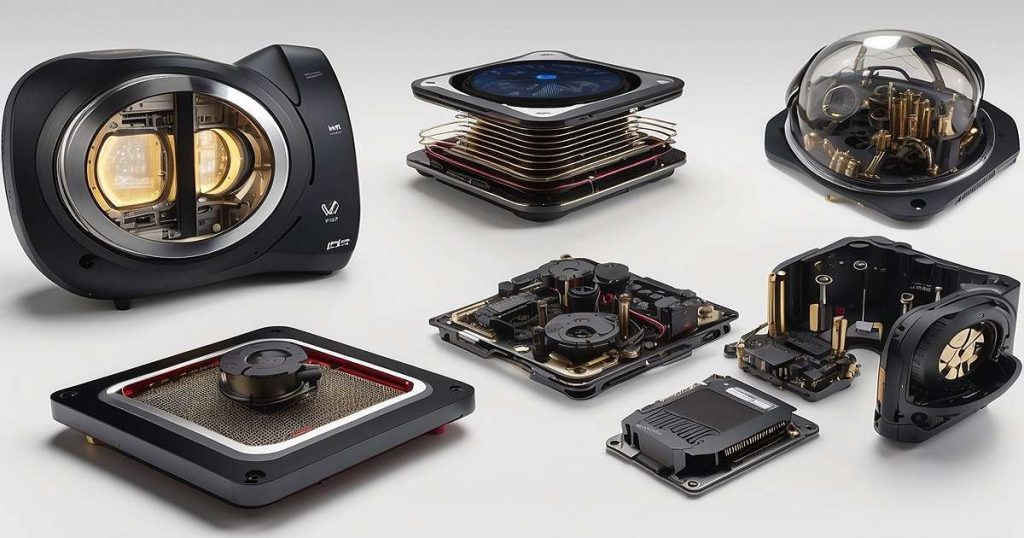
The Cutting-Edge World of Innovative Micro Technology
Micro technology refers to devices and systems built at an extremely small scale, typically measured in micrometers (millionths of a meter). As scientists and engineers push the boundaries of miniaturization, innovative new micro technologies are emerging across a range of applications. These groundbreaking micro systems promise to transform everything from consumer gadgets to medical treatments.
This article explores the latest innovations in [[innovative micro technology]], from increasingly tiny yet powerful integrated circuits to tiny robots measured in microns. Read on for an inside look at how this burgeoning field is evolving to drive the next generation of high-tech products and solutions.
Scaling ICs Smaller Than Ever Through Innovative Micro Technology
For decades, microchip manufacturers have adhered to Moore’s Law, the prediction that the number of transistors squeezed onto integrated circuits would double every two years. Lately, however, chip producers have struggled to maintain this pace as they [[technology|approach fundamental limits]] on miniaturization using conventional silicon-based chips.
Still, innovative alternatives are ensuring the march towards ever-smaller, more powerful microchips continues. Some key trends in downscaling modern ICs include:
- Novel chip architectures: 3D stacking approaches like High Bandwidth Memory integrate storage, memory, graphics, and processing in new ways. These novel architectures optimize data flows while bypassing Moore’s Law’s density challenges.
- Advanced nanotechnologies: Tools like electron beam lithography can pattern nanometer-scale semiconductor components and wires, enabling ICs smaller than 10 nanometers. Some even envision molecular-scale [[nanochips]].
- Specialized fabrication methods: Techniques like extreme ultraviolet lithography (EUV) employ shorter wavelengths of light to imprint smaller circuitry features during manufacturing, circumventing traditional lasers.
As a result of similar innovations, the smallest state-of-the-art microchips now pack over 50 billion transistors into an area the size of a fingernail. And labs around the world are already prototyping working microchips just atoms in width. As researchers uncover new methods for working at ever-smaller scales, the next generation of micro technology will blow away anything we carry in our pockets today.
The Promises and Challenges of Nanoelectronics
Pushing microchip fabrication to the limits brings unique challenges along with immense possibility. As components shrink to nanometer proportions, quantum effects start to dominate over behaviors we understand from the macroscopic world. While this nanoscale realm presents huge advantages for minimized electronics and computing, it also requires radical rethinking of traditional principles.
Some of the key promises include:
- Faster processing: Nanoelectronic components with ultra-small feature sizes operate at significantly higher frequencies compared to conventional transistor circuits. This brings major speed advantages.
- Higher storage density: With storage cells scaled below 30 nanometers, individual flash drives may eventually hold multiple terabytes per chip.
- Lower power draw: Miniaturized nanoelectronics with faster switching speeds reduces voltage needs and power consumption compared to current processors and memory.
- Better sensitivity: Nanosensors leveraging electronic, mechanical or optical nanocomponents exhibit much higher sensitivity compared to conventional sensors, able to detect minute amounts or environmental changes.
To fully leverage these benefits, researchers must also tackle significant physics and manufacturing challenges, including:
- Quantum tunneling issues: Electrons can “tunnel” across barriers they shouldn’t at smaller scales, increasing noise and signal crosstalk. Special insulation is needed to control this.
- Mass production techniques: Conventional top-down lithography struggles at nanoscales so techniques like DNA self-assembly become necessary despite immense precision needed.
- Yield and reliability hurdles: Defects proliferate rapidly across densely-packed nanocircuits and building redundancy requires new tactics. Innovations in fault-tolerant computing help.
- Heat dissipation problems: Concentrated nanoelectronics generate substantial thermal loads needing creative cooling techniques from microchannel liquid cooling to integrated heat spreaders.
Solving these roadblocks to tap nanoelectronics’ full potential keeps researchers busy while promising exponentially increasing computing power beyond the end of Moore’s Law.
Micro-Electro-Mechanical Systems Lead the Way
One breakthrough enabling minimized modern micro technology has been the advent of micro-electro-mechanical systems (MEMS). As the name implies, MEMS devices integrate electrical and mechanical components on a micro scale. Often made using adapted semiconductor manufacturing techniques, these smart systems can sense, process data, and interact with the physical world.
Silicon provides an ideal platform for MEMS thanks to its electronic properties and well-established fabrication techniques. And as engineers integrate more functionality onto single microchips, specialized MEMS devices are emerging, including:
Inertial Sensors
This broad category includes three-axis accelerometers, gyroscopes, and IMUs that enable detailed motion tracking in consumer apps from mobile phones to fitness wearables, gaming systems, AR/VR platforms and autonomous vehicle navigation.
[[[[Innovative micro technology|IMT]] and other [[mems|MEMS]] foundries specialize in silicon-based inertial sensor fabrication using their own specialized process technologies honed through high volume production experience.]] By integrating multiple sensing elements with signal conditioning, calibration, temperature compensation and more onto single microchips, they create world wide technology careers solutions scaling across industries.
Optical MEMS
As the name suggests, micro-optical electromechanical systems employ tiny lenses, mirrors, diffraction gratings, wavelength filters, switches and optical sensors to manipulate light on embedded systems.
Uses span miniature digital projectors for smart glasses and AR displays, biomedical imaging tools small enough to fit through veins, adaptive optics for next-gen telescopes, microscopy components, and active light control across telecommunications networks.
RF MEMS
Applying RF microelectronics to micro electromechanical fabrication opens powerful wireless capabilities. Examples include smart programmable antennas able to steer signals across moving bands, tunable filters/duplexers for multiband radios, and ultra low-loss switches to route high-frequency signals across various stages.
Such components find use in modern equipment including multi-protocol IoT modules, compact meter/phase transceivers, public safety bodycams, 5G base stations and satellite communications. RF MEMS shrink these designs while optimizing performance.
BioMEMS
By integrating lab-on-a-chip style microfluidic actuation with sensors and microelectronics, BioMEMS makes possible highly sensitive analysis of nanoliter biological, chemical and gaseous specimens on incredibly small footprint systems.
Applications span health sensors able to rapidly diagnose patient samples, environmental DNA sequencing, automated drug discovery/toxicology analysis, and micro capillary electrophoresis tools used in forensic labs. Such mobile smart devices continue pushing healthcare diagnostics out of labs and into homes.
As MEMS manufacturing matures, these sophisticated devices will transition from niche industrial and research applications into the mainstream consumer electronics space. The [[mems industry|MEMS industry]] is predicted to top $90 billion annually by 2025.
Bespoke Micro Batteries and Power Sources in Development
Another area seeing focused micro technology innovation is specialized microscale power systems. While electronics can continue to shrink, power sources remain a final barrier for minimizing various technologies. Fortunately, researchers worldwide are making headway building tailored micro batteries and energy harvesters.
Prime applications call for customizable, application-specific designs versus one-size-fits-all solutions. Ongoing research initiatives include:
Microscale Primary Batteries
These purpose-built power sources target low energy devices like smart identification tags, ingestible medical sensors, and industrial environment monitors. Being non-rechargeable, long shelf life and reliable power density takes priority over cycle life.
Techniques like thin-film deposition allow squeezing micro batteries into compact spaces without wires or solder. And novel chemistries balance safety with improved temperature resilience.
Thin-Film Lithium Micro Batteries
With larger storage capacities for more power-hungry applications, these batteries pattern layered anodes, cathodes, electrolytes and substrates using processes adapted from semiconductor manufacturing. This allows sizing thin-film lithium batteries to precision requirements.
Applications range from pacemakers and hearing aids to smart cards to powering remote sensors or electronics needing compact, flat power profiles. Exotic chemistries using graphene and carbon nanotubes promise better charge density and cycle life as manufacturing matures.
Energy Harvesting Microsystems
Tiny photovoltaic cells, thermoelectric generators, piezoelectric films and other transducers can passively harvest ambient solar, mechanical vibration, electromagnetic or thermal energy from the environment and convert it into usable electrical energy. This approach powers electronics without charging.
Ultracapacitors
These store energy physically rather than chemically using oppositely charged conductors with thin dielectric layers between. Known for fast charge/discharge, high power density and stability, micro ultracapacitors complement batteries for intermittent high power demands.
As researchers tailor micro generation, storage and management solutions to specialized niches, they edge closer to independently powered smart microsystems.
Microassembly and Microrobotics Set to Transform Manufacturing
From rethinking medical interventions to enabling the next generation of microelectronics, microrobotics drives many ambitions — yet a key hurdle remains mastering reliable micro scale assembly. To expand adoption, researchers now aim to produce specialized 3D micro gripper systems using batch processes amenable to mass production.
Key innovations in this manufacturing area include:
Monolithic MEMS Microgrippers
These integrated gripping systems leverage planar fabrication processes used for 2D MEMS devices but incorporate hinging, buckling and folding techniques to “pop up” 3D microstructures from the fab surface after release. Features include:
- Hundreds of gripper devices produced simultaneously across a silicon wafer
- Integrated actuators for opening/closing grasping jaws
- Options for passing power, sensors, optics and fluids through the gripper
Such batch fabricated grippers lower costs while bringing standardization for easier micro scale automation.
Laser-Structured Graphene Microgrippers
With laser ablation, it’s possible to pattern integrated graphene microstructures with specialized shapes capable of actuating when exposed to light via photothermal effects.
Benefits include:
- Ability to customize gripper geometry
- Can produce 3D graphene assemblies through layering
- Composition is biocompatible
Hybrid Grasping Strategies
Taking inspiration from nature, researchers are studying biological adhesives and surface tension effects for sticky, controllable micro scale grasping able to work alongside microgrippers.
Examples include synthetically mimicking abalone shell proteins and liquid droplet capillary effects — granting grippers versatility to handle diverse components, including delicate optics and soft hydrogels.
Such micro scale pick-and-place systems show promise across applications including:
Semiconductor Fabrication
Precision manipulation of silicon wafers, lithography masks and other components improves quality in fabrication of ICs, transistors, MEMS devices and more.
Optical Assembly
Assembling components like micromirror arrays for MEMS-based laser scanning devices demands nimble gripping.
Metamaterials Production
Strategic micro assembly of lattices, photonic crystals and other structures grants metamaterials unique mechanical, electromagnetic and quantum properties.
Microsurgery
Delicately manipulating cells, drug carrying vesicles or tissue scaffolds during interventions shows promise but requires advanced robotic precision approaching scales where surface tension dominates over gravity.
As performance improves and micro assembly concepts transition from lab to commercial pipeline, precision automated microfabrication nears the cusp of upending manufacturing.
Microfactories and Nanofactories Promise On-Demand Fabrication
Now imagine the micro assembly principles above scaled to an automated system fitting on your desktop. By integrating microrobotics with additive nanomanufacturing methods, researchers ultimately envision compact microfactories capable of precise, on-demand production of specialized parts and products.
Also called nanofactories in some contexts, these miniature smart workshops promise new paradigms for fabrication including:
Distributed Point-of-Use Manufacturing
Micro production units could reduce supply chains to software build files transmitted for automated execution when and where goods are needed instead of mass centralized factories. This allows customizing output while lowering inventories.
Embeddable Production
Compact microfactories may one day integrate directly into everyday appliances and tools, enabling users to produce spare parts, electronics or specialty materials customized for immediate realities rather than mass market averages.
AI-Optimized Assembly
By incorporating advanced sensing and analytics, automated microfactories may tweak assembly routines based on live feedback and environmental conditions — innovating products in real-time like natural systems. Machine learning will handle complexities surpassing human operators.
Personalized Production
Coupled with databases of user biometrics, medical histories and contextual needs, these agile micro fabrication systems could tailor everything from nutrition supplements to human tissue scaffolds to individual bodies and lifestages — ultimately manufacturing unique solutions on demand.
The microfactory concept marks a radical departure from centralized mass production. Shared across distributed nodes, intelligent localized fabrication may eventually replicate and displace traditional manufacturing sectors. The biggest challenge will be economically justifying additive retooling for small volumes; however proponents argue reductions in supply chain waste offset higher per-unit costs.
Spotlight on IMT’s Specialized MEMS Foundry Process
As a leading pure-play MEMS foundry based in the US, [[Innovative Micro Technology|IMT]] leverages decades of fabrication expertise specifically honed for advanced inertial sensors along with other specialized devices leveraging electromechanical integration.
While outsourcing semiconductor manufacturing to IMT, many fabless micro device firms lean on their differentiated process technology. Some of IMT’s special MEMS capabilities include:
Inertial Sensor Fabrication
Optimized, mature production processes for accelerometers, gyroscopes and 6DOF combos that meet exacting performance, reliability and precision requirements across consumer, industrial, aerospace and defense applications.
Advanced Through-Silicon Vias (TSVs)
Vertically drilling holes through silicon wafers to enable 3D stacking remains challenging with high aspect ratios. IMT produces TSVs allowing multilayer MEMS & IC integration.
Wafer Bonding
Powerful bonding approaches like glass frit bonding that can join wafers with unmatched mechanical strength across large footprints while maintaining electrical isolation enable demanding packages.
Thick Epitaxial Polysilicon Films
Custom tools precisely deposit exceptionally thick (100+ μm) layers of this crystalline silicon film used extensively for inertial sensor elements and cap wafer bonding.
Geometry Scaling to 0.35 μm
Using deep reactive ion etching, IMT attains square micron precision across ultra-small features pushing fabrication limits.
Proprietary Materials
Including unique polysilicon alloys that remain confidential, IMT’s special materials optimize performance in finished devices.
With custom equipment engineered to IMT’s stringent specifications required to attain production-level yields across such precision processes, the company retains a competitive moat — making them a strategic manufacturing partner across the micro device landscape.
Conclusion: Micro Technology Driving the Next Electronics Revolution
As covered across this deep dive, groundbreaking advances in micro technology promise to transform everyday life through disruptive new applications, from extending digital experiences into 3D spaces via AR to democratizing personalized medicine by diagnosing disease at a glance on compact smart devices.
Ongoing areas of focused innovation range from rethinking integrated circuits despite hard limits of physics to minimizing power sources, pioneering automated micro assembly tactics, and developing turnkey MEMs solutions that form perception bridgeheads between electronics and surroundings.
As applications demanding ever more compact and sensitive on-chip systems multiply, researchers continue redefining limits of precision while pooling interdisciplinary expertise to transform smart micro devices niche curiosity into ubiquitous endpoint intelligence expected anywhere, anytime.
The next electronics revolution elbows toward the infinitesimal scale where conventional wisdom fails. By embracing quantum oddities and novel bottom-up techniques, humanity gains strange new tools to digitize reality itself more richly. Only by venturing outside comfort zones can we tap vast latent potential still hiding in far deeper vistas of small.
What is innovative micro technology?
Innovative micro technology refers to cutting-edge technological developments that occur on an extremely small or “micro” scale, such as emerging miniature devices and systems typically measured in micrometers. It includes state-of-the-art microchips, micro-electromechanical systems (MEMS), micro robotics, and nanotechnologies.
What is a micro-electro-mechanical system (MEMS)?
A MEMS device integrates tiny mechanical and electrical components on a microchip using semiconductor manufacturing techniques. It can sense environments, process data, and interact with the physical world. Some common examples are micromirrors, pressure sensors and micro pumps.
What are some innovations in microchip designs?
Innovations allowing further microchip miniaturization include 3D stacking approaches integrating components vertically, nanoscale transistor architecture below 10 nanometers, using extreme ultraviolet radiation for smaller lithography, and even molecular-level nano-components. State-of-the-art microchips now pack billions of transistors where millimeters once held millions.
How small can microchips get?
Labs worldwide are prototyping microchips measuring just a few atoms in width. Scaling electronics down further will require new designs embracing quantum effects rather than fighting them. Smart nanoscale engineering may one day produce advanced nanocomputers.
What’s driving micro battery innovations?
Applications like medical micro-implants, sensors and MEMS devices demand tiny, tailor-made power sources versus one-size-fits-all batteries. Innovations like thin-film lithium batteries, micro fuel cells, solar micro-harvesting and high-density micro-capacitors help address these needs.
How does micro scale assembly work?
Micro assembly allows manipulating tiny components like building blocks to construct novel micro devices and nanotechnologies. Approaches use microgrippers, lasers, micro fluids and even biological principles like cell binding. These assembly cells form miniaturized, automated microfactories that promise customized on-site fabrication.




